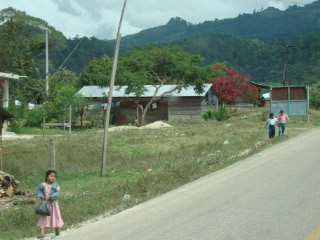
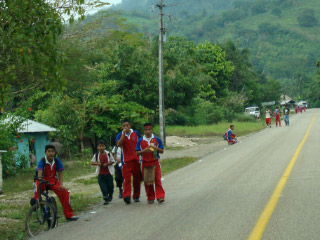
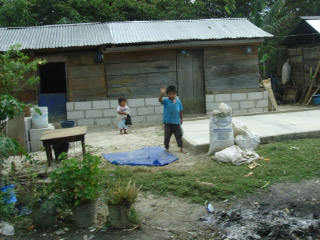
Chapter 8. Northern Chiapas
(Shari) I wish someone had counted topes today. I swear, every half mile had two to three: topes in front of churches, in front of schools, in front of stores and in front of nothing. [I later hear there are ~750 topes]. It takes us 7-1/2 hr. to travel 130 mi. Once our top speed hit 35 mph but it was short lived. We descend from 7500 feet to 300 feet during the 130 miles and wind, twist and turn down, down, down. We travel in pods today, separated by 15 min. The road is too narrow, too twisty to go as a group. Places to take a rest are small, certainly not big enough for 12 rigs and passing a whole caravan would be very difficult for the locals. In addition, parking in Palenque will take time. Our pod arrives at 3:15 and I go to the street to await Pod 2. After a half an hour, I get a bit worried. I find two workers at the hotel to wait for the pods and show them the way in while I return to the rig to start margaritas. Pod 2 and 3 come in pretty close to each other. They stopped at a waterfall to bird and lost track of the time. I hug everybody, just so grateful that they are safe. The schedule gets put back 30 min. Bert gives an overview of our time in Palenque, I serve margaritas and we eat our fill on all the finger foods spread out on the tables.
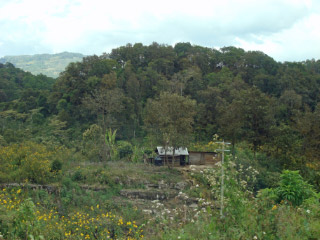
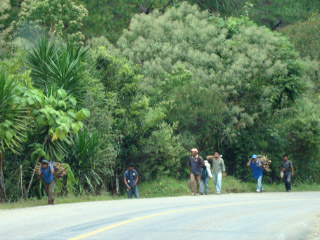
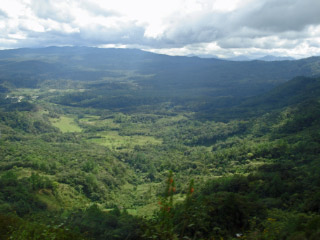
(Bert) Sweet and sour describes today’s travel through the Chiapas highlands, combining stunning mountain scenery, curious cultural studies and painful driving. From San Cristóbal we climb out of the basin and over the edge of the mountains on the Ocosingo Road. Almost continuous settlements crowd along the road with a depth of one building beyond which is a patchwork of cleared forests, remnant wooded stands and various attempts at agriculture, mostly corn fields and sheep raising. Frequently, in the distance, we can see multiple receding ridgelines, mostly empty of shack homes with no apparent roads reaching the remote sites. The highway is a narrow two-lane, without shoulder, with so many road hazards we soon tire of announcing them on the CB: broken pavement, landslides, washouts, cattle, stalled vehicles, accidents, parked vehicles, slow trucks, oncoming 18-wheelers. Tedious topes are more prolific here than any Mexico highway I can recall. Since the villages are almost a continuous chain, so are the topes. And, these speed bumps are built so high that even at barely creeping speed the RV and tow bounce badly when crossing. While a few days ago we climbed 7000+ ft. on a smooth and mostly straight toll road, today we descend the same height but on a poorly constructed, badly in need of repair, twisted road with so many curves they’ve given up on erecting the Zona de Curvas and Curva Peligrosa signs, as the curve zone is many miles in length and all are dangerous if not carefully driven. Out of curiosity, I select a random mile of driving and count 19 curves – probably typical of our hours of driving. The curves are on the downhill, so I am continuously shifting between first, second and third to gauge my engine braking action to the degree of curvature. It takes me 2 hr. 20 min. to travel the first 45 mi.



When not watching the curves, we watch the people. The short-statured women wear bulky full length black woolen skirts and colorful handmade woolen sweaters and blouses. With Mongolian-round faces easily formed into attractive smiles, pitch black hair braided into a single long tail that extends nearly to their waists and the bright clothes, they would make captivating photographic material, yet culturally they do not wish to be photographed. The young children enthusiastically waving as we pass by and the older children in school uniforms that look like colorful jogging suits are more easily photographed. Men show bodies stooped in the work of carrying sticks from the forest and corn from the fields and dark weather-worn faces creased older than their age. The heavy sacks saddle their backs and an attached strap comes forward and wraps across their foreheads. Young mothers, again many looking older than their age, carry children in slings across their backs. People are everywhere we look, many idle, a few working with rocks and cement in an almost hopeless attempt to improve buildings or roads, using hand tools to split rocks, or cultivate fields or mix cement. Some use oxen or donkeys for labor; most seems to be done by hand; almost none uses machines.
(Bert) I am already awake and typing on my computer, but most in camp are still asleep when the alpha male Yucatan Black Howler emits a startling loud howl from the trees just above the RV’s. Good timing, the wake-up call soon gets everyone out to the cars and we leave for birding ten minutes early. We get to the museum parking lot shortly after 6:30 and are surrounded by birds faster than we can strap on our binoculars and get our cameras at the ready. The first ooh-and-aah bird is a Crimson-collared Tanager. Red berries on a tall tree attract euphonias and we find all three expected species: Scrub, Yellow-throated and Olive-backed. For birders not visiting this part of Mexico before, it is one life bird after another: Pale-vented Pigeon, Golden-olive Woodpecker, Chestnut-colored Woodpecker, Streak-headed Woodcreeper, White-collared Swift, White-crowned Parrot and three trogons: Black-headed, Violaceous and Slaty-tailed.
One bird has me stumped, however. High in a tree overhead a large hummingbird
preens. I suspect it is a Purple-crowned Fairy because of its size, completely
white undersides and short straight bill. Then I see the bill is red and I
cannot think of any local bird with that combination. I take photos and then
align my scope and take more photos through the scope. I cannot see any of its
back, but I do notice the head is dark from below the eye upward.
Later, when I
have time to transfer the photos to the computer I recognize it as White-bellied
Emerald, a small hummingbird. I always tell beginning birders not to trust size
as a field mark without an obvious way to compare it to another. I fell into the
trap myself when I misjudged the bird in the tree.
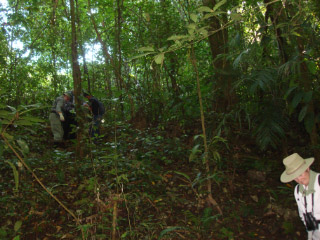
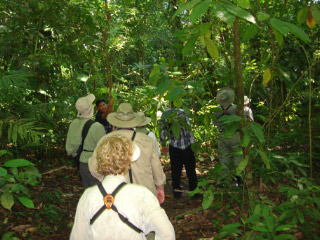
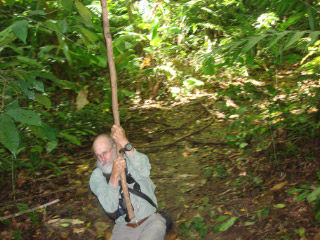
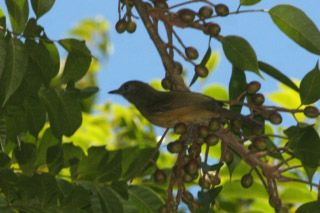 We move our vehicles to the entrance to the ruins and I encounter Salvador
and make an arrangement with him to be a guide for those that want to learn more
about the Mayas and Palenque. A young man named Abram will be a guide for the
rest of us that intend to hike into the surrounding forest for birds. Although
I’ve hiked these woods myself many times, I’ve never tried the narrow and steep
trails that Abram finds. It is quite a struggle for a few in our group and I
wonder why he didn’t choose the main trail. We get to see some good birds,
however, starting with a Tawny-winged Woodcreeper close enough for Bob and me to
photograph
We move our vehicles to the entrance to the ruins and I encounter Salvador
and make an arrangement with him to be a guide for those that want to learn more
about the Mayas and Palenque. A young man named Abram will be a guide for the
rest of us that intend to hike into the surrounding forest for birds. Although
I’ve hiked these woods myself many times, I’ve never tried the narrow and steep
trails that Abram finds. It is quite a struggle for a few in our group and I
wonder why he didn’t choose the main trail. We get to see some good birds,
however, starting with a Tawny-winged Woodcreeper close enough for Bob and me to
photograph. We hear the croaking frog-sounding Keel-billed Toucans and all of
those who have never seen one are anxious, but today they stay hidden in the
canopy. Gordon identifies a Wood Thrush, I find a Royal Flycatcher and we stop
for a Deppe’s Squirrel. Abram knows the trail crosses a particular vine and he
grabs hold of it to swing. Ken slips and struggles to do the same, but it is Tom
Tarzan who shows the real technique just as I catch the blurred motion on
camera.
Finished with the wooded hike through the uncovered ruins, we visit the main
plazas and restored ruins. Birding there is highlighted with two Ochre-bellied
Flycatchers and a Long-billed Hermit feeding on the long drooping blooms of
Tiger Claw (Erythrina indica). The hummingbird uses its long curved bill to lift
up the blooms and insert it several inches to retrieve the nectar.
Later this
evening when I meet Betty she tells me she had 16 life birds today and Jim had
13.
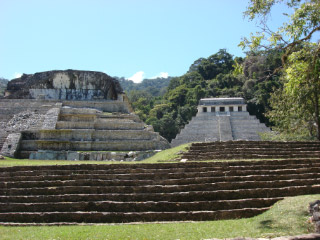
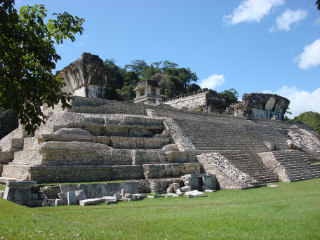
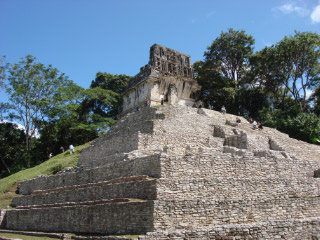
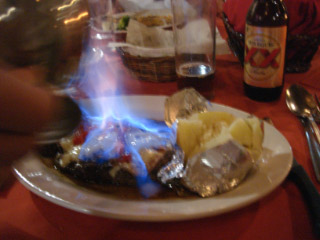 (Shari) Leaving with the late risers, Marlene, Larry and I lead them to the
ruins where we meet the rest of the group. Dividing into two, the birders and
the Maya site seekers, the groups enter the ruins, some to look for lifers,
others to follow Salvadore to learn more of Palenque’s history. Marlene, Larry
and I then drive to do errands, stopping to arrange for the propane truck on
Monday, checking out the battery store for Val who needs a new one, purchasing
supplies for our Valentine party, arranging a group dinner for this evening and
determining the location where John can get his generator fixed. I get home in
time for a nap and a quick swim in the pool before dinner. Eighteen of us go to
Bert and my favorite Mexico restaurant. I must have talked people into the
flaming steak since so many order it. We are not disappointed and the tasty
steak smothered in cheese is flamed with brandy at the table. It is again
delicious.
(Shari) Leaving with the late risers, Marlene, Larry and I lead them to the
ruins where we meet the rest of the group. Dividing into two, the birders and
the Maya site seekers, the groups enter the ruins, some to look for lifers,
others to follow Salvadore to learn more of Palenque’s history. Marlene, Larry
and I then drive to do errands, stopping to arrange for the propane truck on
Monday, checking out the battery store for Val who needs a new one, purchasing
supplies for our Valentine party, arranging a group dinner for this evening and
determining the location where John can get his generator fixed. I get home in
time for a nap and a quick swim in the pool before dinner. Eighteen of us go to
Bert and my favorite Mexico restaurant. I must have talked people into the
flaming steak since so many order it. We are not disappointed and the tasty
steak smothered in cheese is flamed with brandy at the table. It is again
delicious.
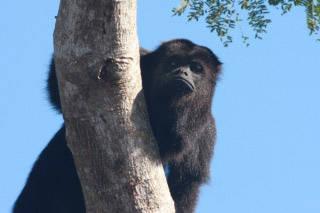 (Bert) Where could you live so that your backyard birds were Bare-throated
Tiger-Heron, Double-striped Thick-knee, Turquoise-browed Motmot, Yellow-headed
Parrot and Painted Bunting, and the animals crawling through the trees above
your patio were Green Iguanas
(Bert) Where could you live so that your backyard birds were Bare-throated
Tiger-Heron, Double-striped Thick-knee, Turquoise-browed Motmot, Yellow-headed
Parrot and Painted Bunting, and the animals crawling through the trees above
your patio were Green Iguanas and Black Howlers? That’s what Rafa has in his
yard, the house next to a slow-moving dark chocolate river with tall sprawling
trees shading the patio, amidst a ranch carved from the jungle in the 1870s. The
motmot waits patiently for all of us to take close-up photos
and we tease Rafa
that he can release the string he uses to secure the motmot. The fifth
generation to live at Finca San Lucia, Rafa has expanded to tourism as a
supplement to raising cattle and crops. He teaches tourism at the nearby college
and three of his students assist today with the ranch-style dinner, serving beef
and vegetables mostly grown on the finca. Led by Rafa, six of the group – John,
Janice, Mike, Charlu, Maxine and Valerie – ride ranch work horses over some of
the 600 hectares. Five of us – Tom, Paul, Pat, Dee and me – take kayaks on the
river. Smartly, we paddle upstream first, without much effort, so that we can
drift downstream on an idyllic day. Neotropic Cormorants and three vulture
species, including Lesser Yellow-headed, are the most common birds. Some of the
others are Bare-throated Tiger-Heron, Black-crowned Night-Heron, Roadside Hawk,
Green and Ringed kingfishers. When we struggle out of the kayaks at the dock, we
join the armchair birders and compare notes. Enthusiastically, they report
seeing a pair of Amazon Kingfishers.
We are anxious for lunch, but must await the return of the horse riders. Strangely, a ranch hand brings back the horses without riders. Twenty minutes later we see them hanging on to the railings and standing on the back of a high backed truck in the style of much rural Mexican transportation. They rode for two and a half hours and some were tired, so this was the easiest way to return quickly. They come with stories of all the birds they saw and especially talk about the Double-striped Thick-knees, Caspian Terns and a Tiger-heron that had usurped an abandoned boat at the lagoon.
The warm weather and activities have made us all thirsty and we delight in a drink made from hibiscus flowers, refilling our tall tumblers several times. After a leisurely dinner under the canopied patio, we head back to Palenque. In the evening, Shari and I swim in the pool only a stone-throw’s distance from our RV.
(Shari) What a fun day! Not many Americans get the chance to ride horseback, kayak and bird on a private Mexican finca. Bert made this contact a few years back and we have been invited every year we come to join the owner Rafa at his ranch. Plus he cooks lunch for us: steak from his cattle. While some ride horses or kayak a large group of us just sit on the patio watching birds and the river and catching the breeze in the shade of the many trees. Pat, Paul and their dog Brutus go kayaking and Brutus wears this cute little life vest. After lunch we return home and nap or swim in the pool before our Valentine party. Two of the quarters in the football pool had no winners and we used the money to make Hummers, an ice cream drink of Kailua and rum. Very good! Heather made cupcakes; John plays the violin; Marlene has everyone guess how many candy corns are in a container. Paul picks the closest count, missing by only three. And Janice and John teach us a game. Nine books are placed on the ground. Someone goes outside the circle while someone else picks a book. The person then has to guess which book was picked. John and Janice get the first few exactly correct, but then begin making mistakes and the hilarity starts. Janice claims that John is not waving his stick properly or that he has had too many hummers. We all have had too many Hummers since other guests at the hotel stop to watch us and wonder what all the racket is about. No one figures out the trick to the game and Janice has to tell us the secret. Janice passes out some candy and we decide if we go to bed right then, we can get nine hours of sleep before we have to get up for tomorrow’s outing. I hear Bert tell someone that the time to rest is when the trip is over and we all are home.
(Shari) I remember as a teenager having to get up at 4:30 AM to get to the Milwaukee produce market by 6, in time to sell the fresh strawberries and corn for the farmer for whom I worked. Then again, I had to get up early to be at my factory job by 7 during college summer break. I vowed I would never get up that early again. A body should not have to go through that torture. Well, today we have to get up at 4:30. Our bus is to arrive at 5:30 to take us to Bonampak. At least I do not have to make breakfast, since it is included in the tour package. By the time I get out the doors, people are already gathering in the morning darkness. I see a light in one of the RV’s from the other caravan and wonder: why would anyone get up at this ungodly hour if they did not have to? I talk little and wait alone by the river. When it is 5:35 and still no bus, I talk to our guide who had arrived earlier and he does not know the answer. At 6 he drives his car to find our bus. The tour company calls on my cell phone and explains that the bus is late. Duh! We know that! The company can arrange for another bus. But Bert’s shrunken disappointed body language tells me that the birding will be lousy and the birders will have missed the best time to see the birds. Half of us don’t care. We pole the group and decide to visit Misol-Ha and Agua Azul today and rearrange the Bonampak tour for tomorrow. The group goes off letting me to work out the details.
Before they all scatter, I walk around with a sign up sheet, to make sure I get all those that want to go on the trip. I go back to the RV to await the tour company call. By 11, and no call, I try to call them. Then I realize, no matter what numbers I punch into the phone I either get deadness or a Spanish-speaking operator telling me that the number is no good. I can call from Mexico to the U.S., from the U.S. to Mexico, but apparently I cannot call Mexico to Mexico. I call the international assist number and let it ring a million times without an answer. I get onto the web and see that all contacts with AT&T are 800 numbers, which will not work outside the U.S. I then e-mail AT&T and get an automatic response that my question will be answered within 48 hr. Too late! I decide to e-mail the tour company and then I wait. I wait until 2 and try e-mailing again. Finally they call me back. Again they are so sorry the bus did not arrive. What can they do? We settle on a free dinner this evening, and a 15-passenger van for the smaller group tomorrow and a refund for those that decided not to go. I go around to each rig individually and explain about dinner tonight. After Bert’s bird talk and bird count we walk to the restaurant and enjoy a good meal that includes cream of cilantro soup (even Bert who dislikes cilantro likes the soup), margarita, mashed potatoes, vegetables, grilled chicken, and bread pudding. We are surprised when we sign for the bill that it comes to $250 pesos per person. It seems expensive, but then again it was free to us.
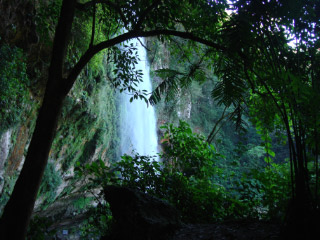 (Bert) By 5:20 all are in line waiting for the bus to arrive. Salvador
arrives, but no bus and none for the next hour despite various phone calls and
excuses. The bus is still promised but by now we don’t want one because it would
make our arrival at Bonampak too late for birding. For those still interested,
we make arrangements for a van to take us tomorrow. We eat a quick breakfast and
most of us carpool to the foothills in the direction of Misol-Ha and Agua Azul,
stopping first at a side road I remember as good birding. I photograph a
Black-headed Saltator.
(Bert) By 5:20 all are in line waiting for the bus to arrive. Salvador
arrives, but no bus and none for the next hour despite various phone calls and
excuses. The bus is still promised but by now we don’t want one because it would
make our arrival at Bonampak too late for birding. For those still interested,
we make arrangements for a van to take us tomorrow. We eat a quick breakfast and
most of us carpool to the foothills in the direction of Misol-Ha and Agua Azul,
stopping first at a side road I remember as good birding. I photograph a
Black-headed Saltator. A Keel-billed Toucan
f
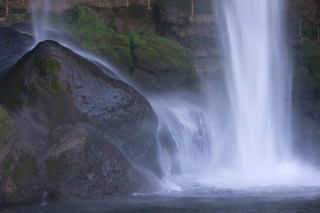 lies over our heads and across the valley, alighting on a distant tree on the
opposite side. I think the toucan is the bird new visitors to the tropics most
want to see. Its outlandish and gaudy bill and colorful yellow, red, white and
black feathers make a cartoon character come alive. We also see its close
relative, the Collared Araçari, a bird with a bill drawn and colored by a
7-year-old with fanciful imagination.
lies over our heads and across the valley, alighting on a distant tree on the
opposite side. I think the toucan is the bird new visitors to the tropics most
want to see. Its outlandish and gaudy bill and colorful yellow, red, white and
black feathers make a cartoon character come alive. We also see its close
relative, the Collared Araçari, a bird with a bill drawn and colored by a
7-year-old with fanciful imagination.
We continue on to Misol-Ha and before we get to the waterfalls we study a
Yellow-bellied Flycatcher who allows close-up photos and then a Northern
Waterthrush perched on the side mirror of a parked car. The waterthrush is so
attached to the mirror that its droppings decorate the top and it does not flush
even when we get surprisingly close to it for photos. We can hear the waterfalls
plunge against rocks and the pool below. When I have it in view, Paul, who
arrived earlier, suggests photographing the silvery stream of water and the
black rocks coated with the splash and runoff from the falls in the morning
light, a rather artistic view.
(Bert) This time the van arrives right on schedule and we leave Palenque at 5:30 AM, still in darkness. Two hours later we arrive at the Bonampak entrance and transfer to a van operated by a Lacandon man, as the local native Indian population controls this part of the country. He speeds down the gravel road through the jungle for 9 km and at 8 AM we stop not far from the airstrip and Maya site. The morning is still cool and birds are singing. We start with a short path into the forest and opposite the modern bathrooms. A young pair of Guineafowl accompanies us for the next hour or so, pecking constantly at the grass as we walk. Perhaps we stir up insects for them. I hear a bird I should recognize, but at first the songs of jungle birds come to me like spring warblers: I have to relearn them each season, associating a visible bird with the voice, before I remember it regularly for the next few months. I get a momentary look at a black bird in the dark shadows and quickly associate the call with Dusky Antbird. Dialing my iPod to the song, the antbird comes out farther for others to see. We do quite well this morning with the elusive deep forest birds, getting looks at Plain Xenops, several Barred Antshrikes, a pair of Dot-winged Antwrens, Thrush-like Schiffornis as well as edge birds Greenish Elaenia, a pair of Bright-rumped Attilas and Cinnamon Becard. In the open areas we have a long opportunity to study a Golden-winged Warbler, too short of a time to identify fast flying Orange-fronted Parakeets and only Gordon and a few others see the Yellow-throated Vireo, partly because there are so many other birds attracting our attention.
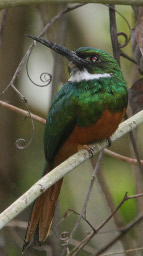
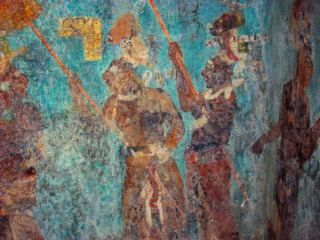 Spurring from the grassy airstrip, I lead the group on a narrow single-file
trail through tall forest. This can be rewarding, but often tough birding as we
cannot see much more than ten feet into the jungle and only glimpses of the
canopy. Everyone sees the Wood Thrush on the path ahead of us, yet only a few
see the Black-faced Grosbeak and Blue-black Grosbeak. At one spot deep in the
forest we see no birds, but I can point in the different directions of those
singing: Short-billed Pigeon, Blue Ground-Dove, Violaceous Trogon, Blue-crowned
Motmot and Long-billed Gnatwren.
Spurring from the grassy airstrip, I lead the group on a narrow single-file
trail through tall forest. This can be rewarding, but often tough birding as we
cannot see much more than ten feet into the jungle and only glimpses of the
canopy. Everyone sees the Wood Thrush on the path ahead of us, yet only a few
see the Black-faced Grosbeak and Blue-black Grosbeak. At one spot deep in the
forest we see no birds, but I can point in the different directions of those
singing: Short-billed Pigeon, Blue Ground-Dove, Violaceous Trogon, Blue-crowned
Motmot and Long-billed Gnatwren.
A pair of Rufous-tailed Jacamars is resting on a vine looped in a U-shape between trees. I explain that it is waiting for an insect to fly nearby when it will suddenly take flight, grab the meal from the air and resume its same perch. No sooner do I get the words out and the jacamar does exactly as told. Then Betty sees a kingfisher-like bird perched near the top the tallest tree. It’s a White-necked Puffbird. Later I hear Jill and Mike, who separated from us when we went single file into the forest, found White-whiskered Puffbird meanwhile.
It’s time to walk to the Maya site and listen to Hector tell us about the royalty that controlled this area and commanded the construction of the temples and the elaborate frescos that commemorate the great wars they fought, especially that lead by Chan Muan after he became ruler in January 15, 776. I know of no other Maya site where one can see frescos like these, still with vivid colors and careful detail. Bonampak was short-lived, starting late and ending early, 300-800 A.D. It is a small Maya site, but a very special one.
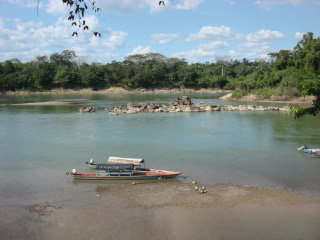 A Short-tailed Hawk circles above the main plaza as we depart and when we
reach the airstrip I find a half dozen King Vultures circling above us. Back on
the van the driver takes us to Frontera Corozal, on the Usumacinta River which
borders Guatemala. After a satisfying lunch, we walk to the river and see the
long boats that can be taken to Yaxchilan where I’ve been before, but no time
for that today. It is already 3 PM and we have more than a two hour drive back
to Palenque. Later this evening Heather is excited to tell me she had 17 life
birds today!
A Short-tailed Hawk circles above the main plaza as we depart and when we
reach the airstrip I find a half dozen King Vultures circling above us. Back on
the van the driver takes us to Frontera Corozal, on the Usumacinta River which
borders Guatemala. After a satisfying lunch, we walk to the river and see the
long boats that can be taken to Yaxchilan where I’ve been before, but no time
for that today. It is already 3 PM and we have more than a two hour drive back
to Palenque. Later this evening Heather is excited to tell me she had 17 life
birds today!
(Shari) Since the birders are not around when I get up, I assume the bus showed up. Meeting with Larry and Marlene, we decide how we will depart in the morning. By 11, we are concerned that the propane truck is not going to show up. Marlene and I drive to the outlet and the manager has decided not to send out the truck as he promised he would do on Saturday. Milo’s generator runs on propane, and he is out. We have to jockey our cars so Milo can get out of his parking place. Val gets a new battery and Jim moves out too to dump his tanks. I think all those left in camp enjoyed our free day either reading or swimming. Many got haircuts. After picking up my laundry, I stop for ice and pollo asada for dinner. The birders come home at 6 and catch us SOBs (Spouses Of Birders) in our own social hour.